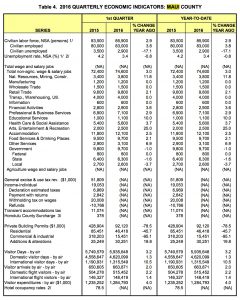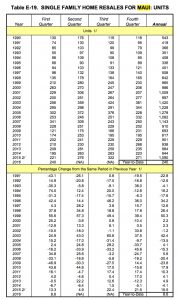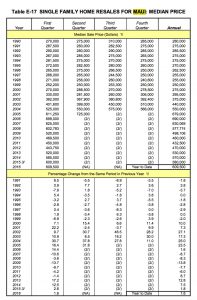Maui County Sees Growth Over First Quarter

Maui County Economic Indicators graphic courtesy DBEBT.
Maui County’s economy experienced gains in jobs, visitor arrivals, visitor days and single-family unit resales and decreases in unemployment, private building permits and authorizations, and condominium unit resales in the first quarter of 2016 compared to statistics from the same quarter last year, according to a recent report released by the Department of Business, Economic Development and Tourism.
Maui County saw a net gain of 2,200 jobs or a 3% increase in the first quarter of 2016 over the same quarter last year. Jobs numbers increased the most in arts, entertainment and recreation (500 jobs), followed by natural resources, mining, construction (400 jobs) and accommodation (300 jobs). Government lost 100 jobs in the quarter.
In the first quarter of 2016, the unemployment rate in Maui County decreased .8% from 4.2% to 3.4%.
 The unemployment rate in all counties decreased, falling under 4% in the first quarter; Honolulu decreased .7% from 3.7% to 3%; Hawai‘i County decreased 1.1% from 4.9% to 3.8%; Kaua‘i County decreased .8% from 4.4% to 3.6%.
The unemployment rate in all counties decreased, falling under 4% in the first quarter; Honolulu decreased .7% from 3.7% to 3%; Hawai‘i County decreased 1.1% from 4.9% to 3.8%; Kaua‘i County decreased .8% from 4.4% to 3.6%.
Visitor arrivals by air increased 2% in Maui County.
 Visitor arrivals increased 3.5% in Honolulu and 1.1% in Hawai‘i County but decreased 1.6% on Kaua‘i.
Visitor arrivals increased 3.5% in Honolulu and 1.1% in Hawai‘i County but decreased 1.6% on Kaua‘i.
Visitor days increased 3.2% in Maui County.
Visitor days increased 2.6% in Honolulu, 1.7% in Hawai‘i County and 1.5% in Kaua‘i, compared to the same quarter of 2015.
The growth rate of private building permits in Maui County decreased $336.8 million or 78.5%.
The growth rate of private building permits in Kaua‘i was positive, which increased $3.1 million or 16.5% from the same quarter of the previous year.
Private building authorizations in Maui County decreased $336.8 million or 78.5 percent, compared with the first quarter of 2015 (Table E-8). In 2015, private building authorizations in Maui increased $287.9 million or 64.9 percent compared with the previous year.
Single-family unit resales increased 8.6%, and condominium unit resales decreased 3.3% in Maui County compared to the same quarter of 2015 (Tables E-19 and E-20).
HAWAI‘I STATISTICS
Statewide, the economy continues strong growth through the first quarter of the year.
“We are pleased to see that during the first quarter, total civilian labor force, civilian employment and civilian non-agriculture payroll jobs were the highest quarterly numbers in Hawai‘i’s history,” said DBEDT Director Luis P. Salaveria. “With nearly 2.2 million visitor arrivals, first quarter 2016 was the second best quarter since visitor numbers were recorded.”
Statewide, general excise tax revenue, an indicator of current economic activities, increased 4.6% in the first quarter the year.
DBEDT expects that Hawai‘i’s economic growth, as measured by the growth of real gross domestic product, will continue the strong growth at 2.3% in 2016 and 2.4%in 2017, unchanged from DBEDT’s February forecast.
These growth rates are higher than the US economic growth rates of 1.8% for 2016 and 2.3% for 2017 predicted by the 50 top economic forecast organizations and published in Blue Chip Economic Indicators.
“Hawai‘i experienced a record year in 2015 for the construction industry,” said Chief State Economist Eugene Tian. “The value of construction completed was $8.1 billion in 2015 and was historically the record high level in nominal terms.”
Construction activities accelerated during the first quarter of 2016. Construction jobs grew 20.4% during the quarter, which was the highest quarterly growth rate since 1990. During March 2016, there were 40,200 construction payroll workers at construction projects in the state, which was the historical record level in Hawai‘i’s history.
However, with the completion of the Ala Moana Shopping Center renovation, the commercial and industrial construction activities will be slowing down this year.
During the first quarter of 2016, a total of 14,400 non-agriculture payroll jobs were added in the economy, representing a 2.3% increase.
All the industries gained jobs except wholesale trade and state government.
The construction industry contributed 46% of the total job gain with an increase of 6,600 jobs.
Food services and drinking establishments added 2,700 jobs to its payroll.
Healthcare and social assistance added 2,500 jobs, and professional and business services added 1,200 jobs.
However, state government lost 700 jobs and wholesale trade lost 200 jobs during the first quarter of 2016 compared with the same quarter a year ago.
Hawai‘i’s unemployment rate during the first quarter of 2016 remained the same as the fourth quarter of 2015 at 3.2% and was the lowest since 2007. Hawai‘i’s unemployment rate ranked the third lowest in the nation among all the states in the first quarter of 2016.
With 688,800 people in the civilian labor force and 667,100 people employed during the first quarter of 2016, the numbers show historical high levels for Hawai‘i. Civilian non-agriculture payroll job count was also at historical high level at 647,200 during the first quarter of this year.
As of the week of May 7, initial unemployment claims in 2016 decreased by 17.4%, from 1,491 claims per week in first quarter 2015 to 1,232 claims per week in first quarter 2016.
Compared with the construction boom during the first quarter of 2015, value of private construction decreased by 58% during the first quarter of 2016. The biggest decrease was the permit value for commercial and industrial, which dropped by 92.1%. Value for residential permits decreased by 53.8% and value for additions and alterations decreased by 32.3% during the first quarter of 2016.
In March 2016, the value of residential permit increased by 10.4% after three months of consecutive declines. Since there is a lag between the time a building permit is issued and the actual construction start, the slowing down in building permits during the first quarter this year will result in slow construction toward the end of 2016.
Visitor arrivals increased by 3.6% and visitor expenditures increased by 2.6% during the first quarter of 2016.
With the data provided, DBEDT expects the payroll job count will grow by 1.8% in 2016, higher than the 1.3% projected in the previous quarter. Job growth is projected to be at the 1.1 to 1.2% for the years after 2016.
DBEDT expects the unemployment rate will drop to 3.2% in 2016, lower than the 3.5% projected last quarter. The unemployment rate is expected to further drop to 3 percent in 2019.
DBEDT expects that visitor arrivals will reach 8.8 million in 2016, which would be a 2.2% increase from 2015. Visitor spending is now projected to increase by 2.5%, slightly up from the 2.4% projected in the previous quarter.
Scheduled air seats increased .5% in the first quarter of 2016, and are expected to increase at the same rate during the second quarter of this year. Visitor arrivals growth in the next few years will be stable, in a range between 1.7 to 1.8%.
Nominal (no inflation adjustment) personal income is projected to grow at 4.8% in 2016, same as the projection in previous quarter. According to the US Bureau of Economic Analysis, Hawai‘i personal income grew by 4.6% in 2015. With a lower inflation rate caused by the lower oil price, Hawai‘i consumers benefited from a stronger purchasing power from income. DBEDT estimated that real personal income increased by 3.6% in 2015 and will increase by 3% in 2016. These real personal income growth rates are the same as those projected in the previous quarter.
DBEDT kept its projection for the consumer inflation rate at 2% for 2016 due to the continued expectation on low oil prices.
New in this report are the data on Hawai‘i homebuyers by type of homes (single family or condominium), by place of buyer’s residence (local, US Mainlander and foreign), and by county of property location.
From 2008 to 2015, a total of 144,382 homes were sold or resold in the state. Of these, 72.7% were purchased by Hawai‘i residents, 23.3% were purchased by people residing on the US Mainland, and residents of foreign countries purchased 4% of these homes. Of these from changed owners, 47% were single-family homes, along with 53% from condominiums.
The DBEDT Quarterly Statistical and Economic Report contains more than 100 tables of the most recent quarterly data on the state’s economy, as well as narrative explanations of the trends in these data.
The full report can be downloaded here.










